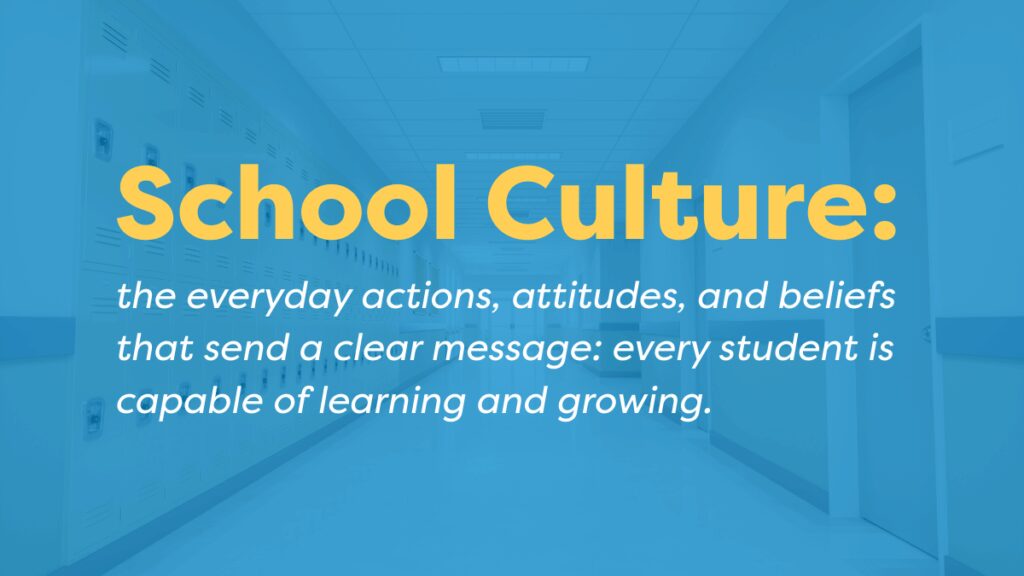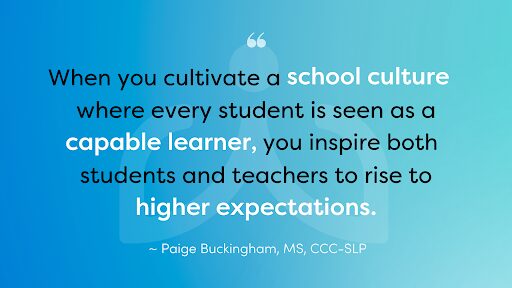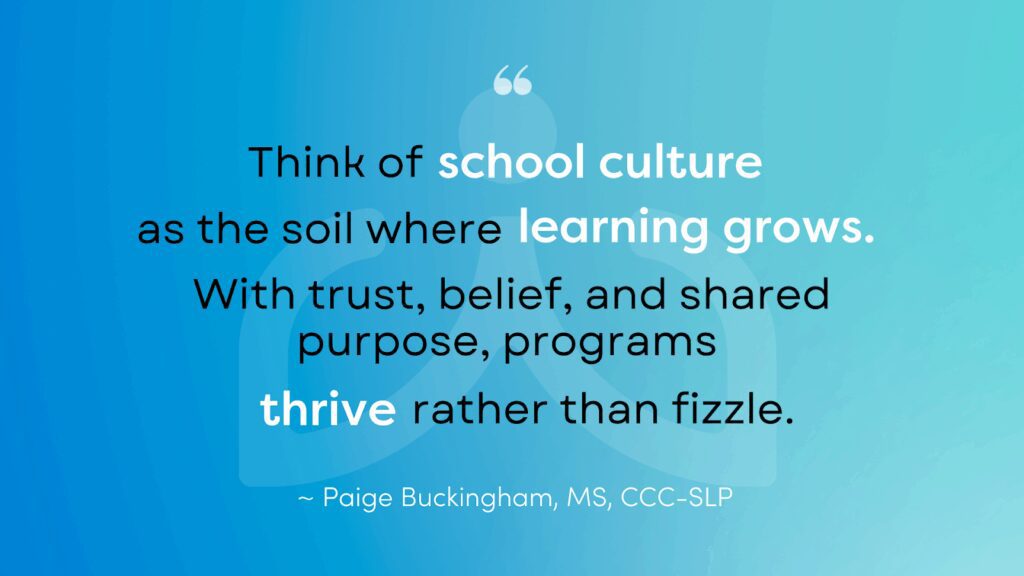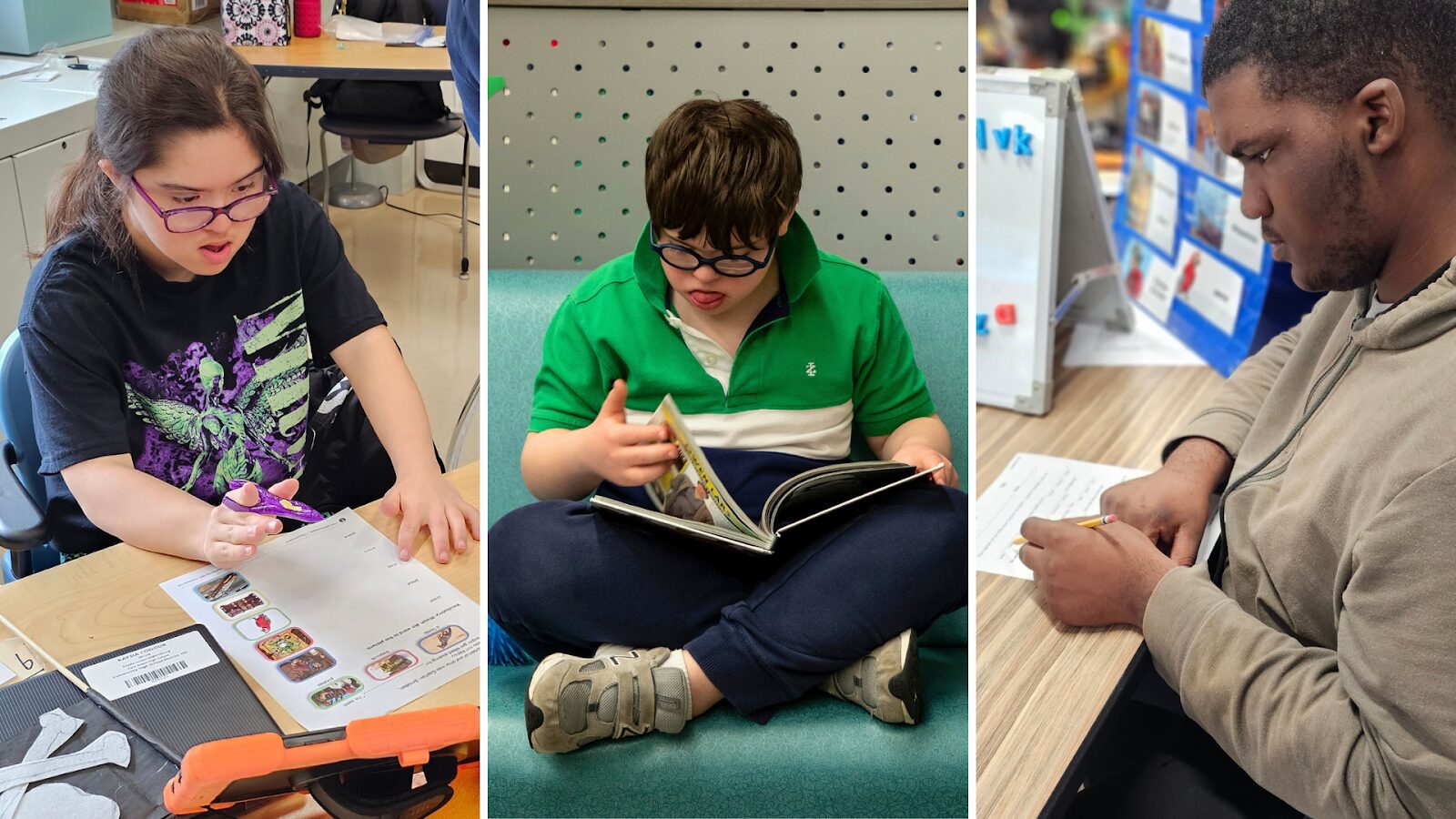How School Culture Impacts
High Expectations For Learners
What helps K-12 educators and students truly thrive? For Paige Buckingham, MS, CCC-SLP, a special education facilitator with 32 years of experience in public education, the answer lies deeper than programs and policies. It comes down to school culture—the everyday actions, attitudes, and beliefs that send a clear message: every student is capable of learning and growing.

In her webinar for Building Wings, “Beyond Belief: Building Teacher Buy-In for Comprehensive Literacy for All,” Buckingham shares practical strategies to strengthen belief in student potential, foster teacher buy-in for new programs, and put comprehensive literacy for all into practice. Here’s how she said schools can start—right now.
School Culture at a Glance:
- Think of school culture as “the soil where learning grows.” With trust, belief, and shared purpose, programs thrive rather than fizzle
- Elevating school culture can also improve teacher retention and reduce chronic student absenteeism
- Sharing classroom stories and student accomplishments can help spark belief in student capability
- Shifting a teacher’s mindset from resistance to ownership can be accomplished when educators are included and their needs are addressed
- Enhance school culture by asking staff for feedback, respecting their time, and celebrating their accomplishments
The Impact of School Culture
School culture isn’t a poster on a wall or a list of community expectations in an administrator’s office. It’s the atmosphere students feel when they walk in the door, the tone in teachers’ voices, and the beliefs that echo in every classroom and hallway.
Research backs this up. According to the Learning Policy Institute’s report on teacher turnover, schools with strong, positive cultures see a 29% higher teacher retention rate. Cultures like these also reduce chronic absenteeism by 10–15%.
In schools, relationships matter, and consistency is key for learning. When students can trust in a stable staff and feel that their school prioritizes their sense of belonging, they stay engaged and connected.
“When you cultivate a school culture where every student is seen as a capable learner, you inspire both students and teachers to rise to higher expectations,” Buckingham explained.
What Keeps Teachers From Buying In?
Resistance to “buying in” doesn’t mean teachers don’t care, Buckingham says. It means they’re afraid. In her words: “People don’t resist change. They resist being changed.”
She cites a number of resources for building teacher buy-in, including six human needs that must be met to facilitate acceptance and for educators to embrace change:
- Autonomy
- Belonging
- Competence
- Purpose
- Self-esteem
- Trust
When these needs are met, teachers can set aside their skepticism and become collaborators. That’s where high expectations for students begin to grow.

How Do You Show Every Student is a Capable Learner?
In the webinar, Buckingham told the story of a powerful moment with a student. A middle schooler who relied on augmentative communication was being read picture books, with the teacher assuming that type of text was appropriate for his literacy level.
When a different educator made the age-respectful decision to read to the student from a Harry Potter book rather than a picture book, he showed visible signs of enjoyment, including a big smile and strong eye contact. Intrigued, Buckingham asked the student to answer ten “yes or no”-style questions about the book. The student answered 80% of those correctly.
“There was no doubt this young man was enjoying the book, understood the book, and it was very appropriate for him,” Buckingham said.
That moment reshaped the way staff saw the student. By presuming competence and giving the student access to a meaningful, age-appropriate text, the educators saw firsthand a student rising to meet his potential.
Why Shared Language Matters, Especially Around Literacy
When teachers talk about “literacy,” they’re not always describing the same thing. Buckingham emphasized how important it is to define the terms for a shared language around literacy, asking, “When we say literacy, what does that mean to each person? Without a shared vocabulary, we risk misalignment and low expectations.”
Defining terms such as “comprehensive literacy for all” helps avoid confusion and keeps expectations high. It also ensures that everyone, from teachers to paras to families, is working toward the same goal: giving every student access to meaningful and age-respectful literacy experiences.
The Power of Collective Teacher Efficacy
One teacher’s success can have a ripple effect throughout the whole school by building the belief that each teacher has the power to impact a school’s learning environment.. John Hattie’s research on “collective teacher efficacy” (CTE) shows that collaboration among educators is one of the most powerful drivers of student learning.
To build it, Buckingham recommends:
- Starting with one or two enthusiastic teachers and letting their wins lead the way
- Sharing success stories school-wide to spark momentum
- Increasing availability of resources that build incremental learning gains including accessible, age-appropriate, and curriculum-aligned texts
- Bringing staff into the decision-making process so they feel invested. To paraphrase Buckingham: If you want buy-in, give people real input. Ask for their feedback, respect their time, and celebrate their accomplishments.
Actively Shaping School Culture
For those who want to kindle a school culture of high expectations, Buckingham recommends starting with three focus areas:
- Listening to teachers’ needs to foster faster educator buy-in. Meet essential human needs before asking for change.
- Presuming competence and providing access to accessible texts to achieve age-respectful, differentiated literacy instruction.
- Thinking of school culture as “the soil where learning grows.” With trust, belief, and shared purpose, programs thrive rather than fizzle.

Creating a School Culture Where All Students Are Seen as Capable Learners
School culture is shaped by the small choices people make every day. When teachers believe in the power of their collective impact, and when every student is seen as a fully capable learner, high expectations are no longer abstract ideas. They start showing up in real classrooms, every day, for every learner.


